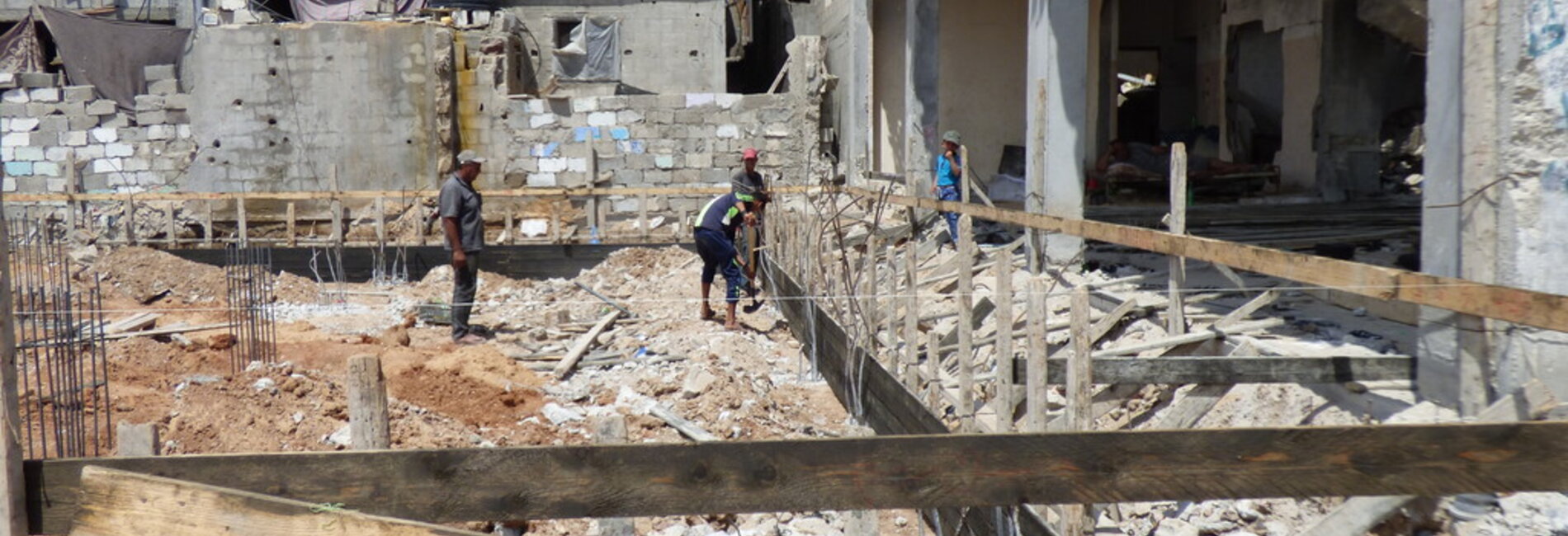Update on Gaza shelter situation
Reconstruction of destroyed homes finally begins in Gaza
The construction materials needed to repair the enormous damage resulting from the 2014 hostilities have been entering Gaza since October 2014 under the framework of the Gaza Reconstruction Mechanism (GRM). To date, over 90,000 households have accessed construction materials, under a process known as the “shelter repair stream” with new submissions and processing and verification of applicants ongoing. According to the latest Shelter Cluster update, over 157,000 housing units were damaged to some degree, ranging from minor to severe, during the 2014 hostilities.
The Shelter Cluster also estimates that approximately 12,580 homes were completely destroyed during the 2014 hostilities. While the “shelter repair stream” has been gathering pace, the first year since the start of the hostilities passed without a single destroyed home being reconstructed, and an estimated 100,000 IDPs remain homeless. Key reasons include Israel’s longstanding restrictions on the import of building materials defined as “dual use items”; the slow pace of disbursement of pledges made by member states for reconstruction; and the inability of the Palestinian Government of National Consensus to assume effective government functions in Gaza, due to the ongoing internal divide. On present progress, it will take years to address the massive reconstruction and repair needs, adding to the general frustration of the population following years of movement restrictions and rising unemployment and poverty.
The introduction of the “residential stream” of the GRM in July has enabled beneficiaries in Gaza to access materials for the reconstruction of homes that were completely destroyed. The “residential stream” will also permit the construction of new housing, which is crucial to meet the housing deficit from natural growth and from previous conflicts,estimated cumulatively at around 70,000 housing units. As of 21 August, some 2,242 beneficiaries were participating in the “residential stream”, including over 700 who have already procured the required construction materials and another 1,500 approved to purchase through authorized vendors.
Profiling of Internally Displaced Persons (IDPs) begins
In another measure to address the vulnerability of IDPs, the IDP Re-registration and Vulnerability Profiling exercise began in Gaza on 19 August. This is a joint initiative coordinated by the IDP Working Group,* to re-register all IDPs who lost their homes as a result of the 2014 hostilities and to better assess their humanitarian needs.
At the peak of the conflict, nearly 500,000 people were temporarily displaced (28 per cent of the population), of whom approximately 100,000 remained displaced. During the hostilities, UNRWA and the Ministry of Social Affairs (MoSA) in Gaza conducted an initial registration of IDPs. However, following the ceasefire on 26 August 2014, no organized deregistration process took place due to the large number of people leaving shelters simultaneously, hampering the ability of humanitarian actors to assess the needs, living conditions, vulnerabilities and specific needs of IDPs in Gaza.
The IDP exercise aims to address this gap by providing a comprehensive overview of IDP needs, locations and current dwellings. It is being carried out in close cooperation with the relevant authorities, municipalities and IDPs themselves. The main implementing partners include national and international NGOs, UN agencies and local authorities. The profiling exercise began in Rafah governorate, following an induction period where the questionnaire was tested in the field and revised accordingly, and training conducted for field staff. Some 250 field workers will be deployed in all five governorates of Gaza. The data collection phase is scheduled to last from around eight to 10 weeks, and aims to cover approximately 18,000 internally displaced families across Gaza at the house-hold level.
* This was formed following a request by the Inter Cluster Coordination Group (ICCG) in order to improve the overall IDPs discussions and help in reporting on the needs and gaps in the IDP response.










